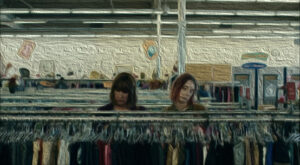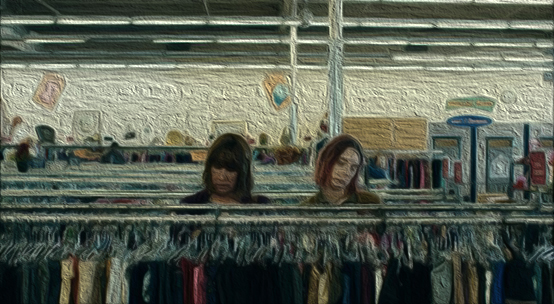
Greta Gerwig seems to have been the woman in film of the past decade. Starting out as an actress and writer, she has fully morphed into a writer-director with her solo cinematic debut Lady Bird (2017).
The film is a coming-of-age story of the eponymous protagonist (Saoirse Ronan) in her senior year at high school. Her coming of age seems aimless, with the structure of Gerwig’s story being more fragmented than concise and offering only a patchwork of selected moments from Lady Bird’s final year rather than its cohesive picture. Lady Bird goes through typical teen rites-of-passage such as experiencing her first love and first heartbreak, loss of virginity, attending the prom, whilst also auditioning for school play, going to parties and being continuously at odds with her mother (Laurie Metcalf). Lacking control in other aspects of her life, she exercises her agency by renaming herself and through identity performances constructed mainly by clothing.
Thanks to the film’s success at the festival circuit followed by a triumphant box office, and thanks to Gerwig’s creator persona which unites hipsterism and mainstream, she has become ubiquitous, and her identity as a one-of-a-kind filmmaker has been unquestionable. Her energy, her cinematic way of seeing and thinking, and her distinctive style, are a breath of fresh air in a predominantly male industry which has communicated predominantly male point of view since its dawn.
However, Gerwig is also – not-so-secretly, but perhaps surprisingly – conservative. This characteristic of her work has been overlooked, namely because she is a female filmmaker and her very existence within the industry poses a subversion. What is more, her conservatism does not take away from the richness of her work. It makes it hers – specific yet relatable.
In Lady Bird the protagonist is a wide-eyed, teenage, identity hunter. She has a healthy appetite for newness with a sprinkle of narcissism on top – the kind we all remember feeling not so long ago. She is uncertain, at times unlikeable. She is a teen who shows ambivalence and contradictions of adolescence, which only become heightened by the contradictive messages of the post-feminist age of the early 21st century which she occupies. At the same time, and despite her ubiquitous scowl, her vibrant pink hair and grungy denim jacket, she longs to simply belong. One example of how her desire to fit in, as well as the facet that shows off Gerwig’s conservatism, is communicated visually through Lady Bird’s wardrobe.
True to Gerwig’s contention that in coming-of-age narratives the question should not be whether the female protagonist will “find the right guy,” but rather whether she is “going to occupy her personhood” (Zuckerman, 2017); her protagonist is in the process of becoming through trial and error, especially visible in her appearance on those special occasions. In Lady Bird the romantic narrative arc is not missing, but it becomes formative only to the extent of any other rite-of-passage the protagonist undergoes. Although on an average day she seems to have a lukewarm relationship with fashion at best, she takes dressing for special occasions very seriously.
As Smith (2017, p. 68) points out, clothing emerges in teen films as a key mechanism through which femininity – and class – are negotiated. This is also the case for Lady Bird: she imitates the picture of middle-class femininity in order to fit in when she meets her boyfriend’s (Lucas Hedges) wealthy family as well as when she chooses her prom dress. For both occasions she wears a different pink gown in a traditional A-line silhouette, completing the look with a pearl necklace. Lady Bird’s endeavours to pass as middle-class and therefore escape her working-class positioning are not attempts to trouble normativity. Instead, she attains legitimacy in terms of the prevailing norm.
This performance of traditional conservative femininity is her individual free choice, and therefore conflates feminism and femininity in a post-feminist vein usual for the teen genre of the past decades. However, Gerwig’s interpretation of teenage dress-up stands apart. Instead of makeover scenes filled with luxury, she offers underwhelming browsing in a charity shop. Teenage dream meets realism when Lady Bird has to make do with what she can afford. Despite following the post-feminist consumer-based logic, Gerwig avoids scenes of conspicuous consumption which often accompany it.
The film, referencing other teen films explicitly as well through Lady Bird’s makeover, also aims to belong. Gerwig situates her film within the teen film genre of the post-feminist vein – such as She’s All That (1999), The Princess Diaries (2001) – simultaneously quoting the genre and subverting it.
Despite operating within post-feminist sensibility, Gerwig simultaneously defies the post-feminist label through avoidance of conspicuous consumption and extending the open-endedness of her protagonist to the structure of the narrative. It is not insignificant that the film’s structure seems to mirror Lady Bird’s aimlessness, incompleteness. Her becoming is depicted in what Pinkerton (2018) describes as a “steady trot of clipped vignettes”, which he also adds are seemingly “monotonous and somewhat evasive”, often ending with piquant punchlines which place the heroine in a “just-slightly unflattering light.” The vignettes do not offer the highlights but both highs and lows, trials and errors. Lady Bird’s story – like her identity – is meandering, seeking, mundane.
Gerwig’s conservatism is not strict nor alienating. It helps to make the lonely process of becoming more relatable and palatable. In this film, she treads (as she has done in her career) between conventionalism and mild subversion, making the latter more palatable through the former. We understand Lady Bird and her desire to sit with the cool kids because we, too, have once – maybe even literally – shopped for our personalities.
Gerwig’s films and her heroines seek for understanding and harmony. They do so in what sometimes seems like a rebellious way. They are outspoken and direct and therefore subversive, just as Gerwig’s style and screenplay are quirky and one of a kind. Because she works with what is mainstream in a singularly and refreshingly honest way, daring to make the point through her sometimes-unlikeable heroine, she gets away with nearly glamorising the white middle-class affluence.
She is an original female filmmaker, and although she may not be as subversive as is generally assumed, she is undoubtedly holding a mirror (albeit a mildly subjective, personal one) to what the human experience feels like – which is all we can ask for.
Bibliography
Pinkerton, A. (2018, June 19). Lady Bird review: Greta Gerwig sketches scenes from an awkward adolescence. Sight & Sound. https://www2.bfi.org.uk/news-opinion/sight-sound-magazine/reviews-recommendations/lady-bird-greta-gerwig-sketches-awkward-adolescence
Smith, F. (2017). Rethinking the Hollywood teen movie: Gender, genre and identity. Edinburgh: Edinburgh University Press.
Zuckerman, E. (2017, November 6). How Greta Gerwig Turned the Personal ‘Lady Bird’ Into a Perfect Movie. Rolling Stone. https://www.rollingstone.com/movies/movie-features/how-greta-gerwig-turned-the-personal-lady-bird-into-a-perfect-movie-126300/
Written by Slavomíra Nemčíková for The Film Dispatch.

